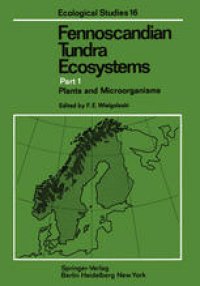
Ebook: Fennoscandian Tundra Ecosystems: Part 1 Plants and Microorganisms
- Tags: Life Sciences general, Biomedicine general
- Series: Ecological Studies 16
- Year: 1975
- Publisher: Springer-Verlag Berlin Heidelberg
- Edition: 1
- Language: English
- pdf
The term Fennoscandia is used to denote Finland and the Scandinavian peninsula, which comprises Norway and Sweden and sometimes also neigh bouring districts of the USSR. The western part of the Scandinavian peninsula is mountainous with peaks mostly within the range 1000-2000 m above sea level. Permafrost is not usually found in the southern districts of these alpine zones, but occurs in the northeastern part of Fennoscandia in mire, even at a low elevation. If tundra is defined as areas of permafrost, only very limited regions of Fennoscandia could be included. However, in the present volumes, we have used the word tundra in a broader sense as approximating areas with mean annual air 0 temperature below 0 C at meteorological standard height (1.5-2 m); it is often used in this sense in North America. This usage allows all alpine zones to be included, along with the subalpine birch zone and certain open subarctic woodland ("forest tundra" in Russian usage).
Content:
Front Matter....Pages I-XV
Front Matter....Pages 1-1
Description of Fennoscandian Tundra Ecosystems....Pages 3-28
Front Matter....Pages 29-29
Soils of Fennoscandian IBP Tundra Ecosystems....Pages 31-40
Climate and Hydrology of Some Fennoscandian Tundra Ecosystems....Pages 41-53
Front Matter....Pages 55-55
Introduction....Pages 57-61
Flora and Plant Sociology in Fennoscandian Tundra Areas....Pages 62-67
Survey of the Main Plant Communities on Hardangervidda....Pages 68-73
Vegetation Mapping at Hardangervidda....Pages 74-81
Dispersal and Primary Establishment of Vegetation....Pages 82-85
Comparison of Plant Structure on Grazed and Ungrazed Tundra Meadows....Pages 86-93
Plant Phenology of Fennoscandian Tundra Areas....Pages 94-102
Measurement of Leaf Areas and Leaf Angles of Plants at Hardangervidda, Norway....Pages 103-110
Plant Biomass and Primary Production of Fennoscandian Subarctic and Subalpine Forests and of Alpine Willow and Heath Ecosystems....Pages 111-120
Primary Productivity of Alpine Meadow Communities....Pages 121-128
Growth in Populations of Andromeda polifolia on a Subarctic Mire....Pages 129-134
Weight Increase of Some Lichens as Related to Carbon Dioxide Exchange and Thallus Moisture....Pages 135-137
CO2 Exchange and Growth of Rhacomitrium lanuginosum and Dicranum elongatum....Pages 138-148
On the Effect of Continuous Light on Photosynthesis in Mosses....Pages 149-162
Acclimatization Effect in Photosynthesis and Respiration....Pages 163-167
CO2 Exchange in Norwegian Tundra Plants Studied by Infrared Gas Analyzer Technique....Pages 168-183
Photosynthesis and Respiration of Plants Studied by Field Technique at Hardangervidda, Norway....Pages 184-193
Front Matter....Pages 55-55
The Seasonal Pattern of Photosynthesis of Some Vascular Plants on a Subarctic Mire....Pages 194-200
Energy Content and Use of Solar Radiation of Fennoscandian Tundra Plants....Pages 201-207
Distribution of 14C Photosynthates in Norwegian Alpine Plants....Pages 208-215
Pigment Structure of Vascular Plants, Mosses and Lichens at Hardangervidda, Norway....Pages 216-224
Front Matter....Pages 225-225
Introduction....Pages 227-229
Decomposition, Microbiology, and Ecosystem Analysis....Pages 230-238
Biomass and Production of Soil and Litter Fungi at Scandinavian Tundra Sites....Pages 239-243
Microfungal Populations of the Abisko Area, Northern Sweden....Pages 244-250
Bacterial Populations of Some Fennoscandian Tundra Soils....Pages 251-260
Comparisons of Decomposition Rates Measured by Means of Cellulose....Pages 261-267
Plant Litter Decomposition at Fennoscandian Tundra Sites....Pages 268-278
Carbon Losses from Tundra Soils....Pages 279-286
Front Matter....Pages 287-287
Introduction....Pages 289-291
Nitrogen Fixation in Lichens at Kevo, North-Finland....Pages 292-304
Nitrogen Fixation by Bacteria and Free-Living Blue-Green Algae in Tundra Areas....Pages 305-315
Mineral Content of Tundra and Forest Tundra Plants in Fennoscandia....Pages 316-332
Analysis of Precipitation at Fennoscandian Tundra Sites....Pages 333-338
Organic Compounds in Alpine Plants....Pages 339-350
The Input and Significance of Particulate Terrestrial Organic Carbon in a Subalpine Freshwater Ecosystem....Pages 351-359
Back Matter....Pages 360-367
Content:
Front Matter....Pages I-XV
Front Matter....Pages 1-1
Description of Fennoscandian Tundra Ecosystems....Pages 3-28
Front Matter....Pages 29-29
Soils of Fennoscandian IBP Tundra Ecosystems....Pages 31-40
Climate and Hydrology of Some Fennoscandian Tundra Ecosystems....Pages 41-53
Front Matter....Pages 55-55
Introduction....Pages 57-61
Flora and Plant Sociology in Fennoscandian Tundra Areas....Pages 62-67
Survey of the Main Plant Communities on Hardangervidda....Pages 68-73
Vegetation Mapping at Hardangervidda....Pages 74-81
Dispersal and Primary Establishment of Vegetation....Pages 82-85
Comparison of Plant Structure on Grazed and Ungrazed Tundra Meadows....Pages 86-93
Plant Phenology of Fennoscandian Tundra Areas....Pages 94-102
Measurement of Leaf Areas and Leaf Angles of Plants at Hardangervidda, Norway....Pages 103-110
Plant Biomass and Primary Production of Fennoscandian Subarctic and Subalpine Forests and of Alpine Willow and Heath Ecosystems....Pages 111-120
Primary Productivity of Alpine Meadow Communities....Pages 121-128
Growth in Populations of Andromeda polifolia on a Subarctic Mire....Pages 129-134
Weight Increase of Some Lichens as Related to Carbon Dioxide Exchange and Thallus Moisture....Pages 135-137
CO2 Exchange and Growth of Rhacomitrium lanuginosum and Dicranum elongatum....Pages 138-148
On the Effect of Continuous Light on Photosynthesis in Mosses....Pages 149-162
Acclimatization Effect in Photosynthesis and Respiration....Pages 163-167
CO2 Exchange in Norwegian Tundra Plants Studied by Infrared Gas Analyzer Technique....Pages 168-183
Photosynthesis and Respiration of Plants Studied by Field Technique at Hardangervidda, Norway....Pages 184-193
Front Matter....Pages 55-55
The Seasonal Pattern of Photosynthesis of Some Vascular Plants on a Subarctic Mire....Pages 194-200
Energy Content and Use of Solar Radiation of Fennoscandian Tundra Plants....Pages 201-207
Distribution of 14C Photosynthates in Norwegian Alpine Plants....Pages 208-215
Pigment Structure of Vascular Plants, Mosses and Lichens at Hardangervidda, Norway....Pages 216-224
Front Matter....Pages 225-225
Introduction....Pages 227-229
Decomposition, Microbiology, and Ecosystem Analysis....Pages 230-238
Biomass and Production of Soil and Litter Fungi at Scandinavian Tundra Sites....Pages 239-243
Microfungal Populations of the Abisko Area, Northern Sweden....Pages 244-250
Bacterial Populations of Some Fennoscandian Tundra Soils....Pages 251-260
Comparisons of Decomposition Rates Measured by Means of Cellulose....Pages 261-267
Plant Litter Decomposition at Fennoscandian Tundra Sites....Pages 268-278
Carbon Losses from Tundra Soils....Pages 279-286
Front Matter....Pages 287-287
Introduction....Pages 289-291
Nitrogen Fixation in Lichens at Kevo, North-Finland....Pages 292-304
Nitrogen Fixation by Bacteria and Free-Living Blue-Green Algae in Tundra Areas....Pages 305-315
Mineral Content of Tundra and Forest Tundra Plants in Fennoscandia....Pages 316-332
Analysis of Precipitation at Fennoscandian Tundra Sites....Pages 333-338
Organic Compounds in Alpine Plants....Pages 339-350
The Input and Significance of Particulate Terrestrial Organic Carbon in a Subalpine Freshwater Ecosystem....Pages 351-359
Back Matter....Pages 360-367
....